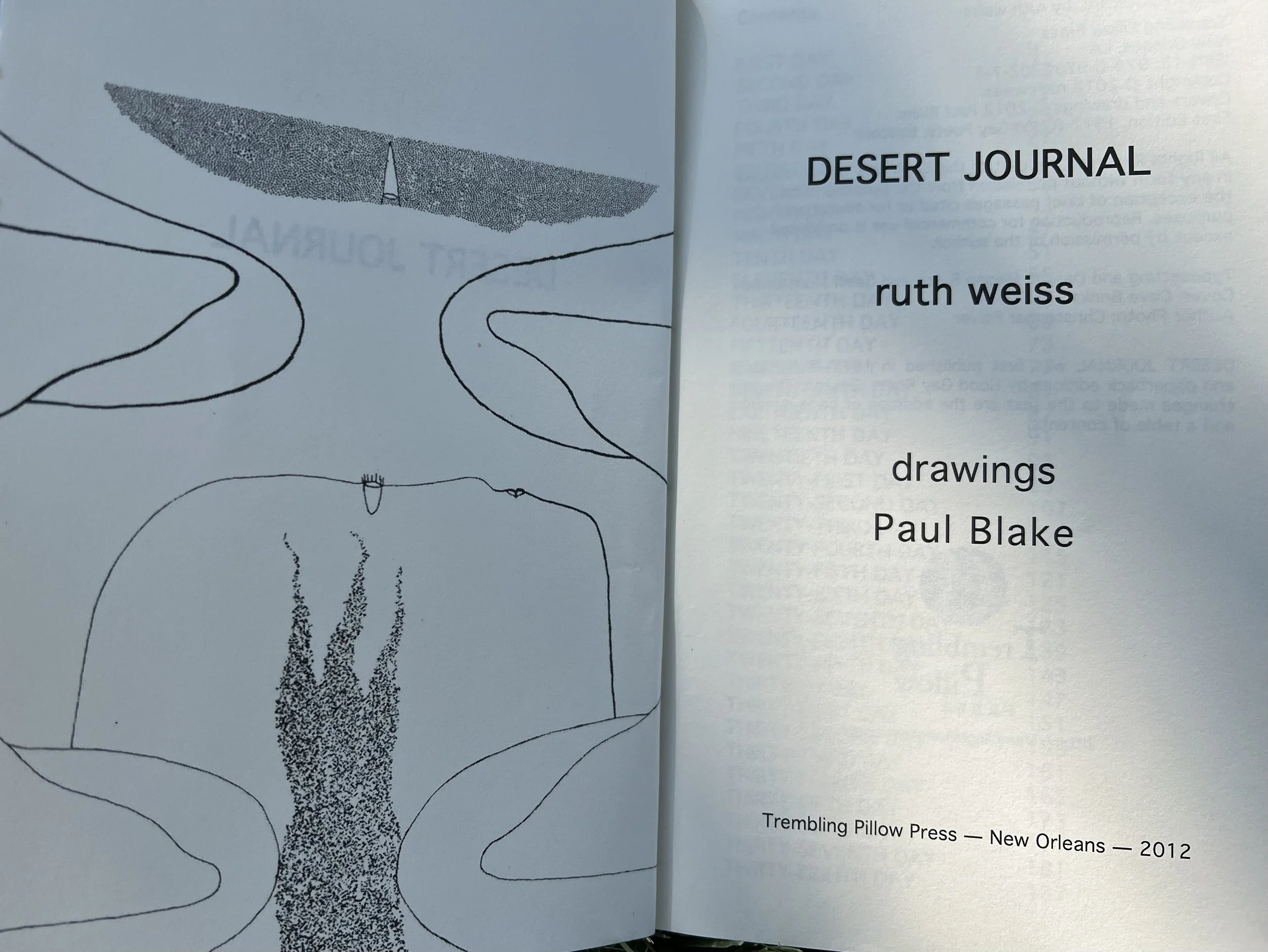Spiritual ruth
In a search for spiritual meaning, ruth weiss’s poetry blends religious references from the west and east, pulling from her cultural background as a European jew and her education in Buddhism.
ruth weiss’s first husband was Mel Weizman. During their marriage, Mel became a scholar of Zen Buddhism, and was a guide at the Berkeley Zen Center, in Berkeley, California. ruth weiss’s familiarity with Buddhism influenced her work- in DESERT JOURNAL, on TWENTY-SEVENTH DAY, the word "kalpa" is used twice. In Buddhist and Hindu cosmology, the word translates into "eon", or an incomprehensibly long amount of time, during which a universe is formed and destroyed.
A photo of the first page of TWENTY-SEVENTH DAY in DESERT JOURNAL. Originally published in 1977 by Good Gay Poets of Boston and re-published at the Trembling Pillow Press in New Orleans, Louisiana in 2012.
One definition of a kalpa from Buddhist tradition goes like this: suppose there is a solid rock one cubic mile in size, and once every hundred years a piece of silk is rubbed against this rock. When the rock has been completely worn away by the silk, one kalpa still will not have passed.
Here is the full poem of TWENTY-SEVENTH DAY
——————————————————
TWENTY-SEVENTH DAY
from yearning-peak
to yearning-peak
an angel streaks
a rush of wings
barely brushing
Its cycle against the foot of the horizon
KALPA!
moth-circle
the wheel in the structure
a warning
a confirmation
from out of the past
come the questions
one has to tread softly
not to shatter illusion
all at once
in that instant
boulders are born
to roll wild & measured
against the foot of the horizon
still they are only of sand
and sly
no nearer to the goal
only enough of a change
to give a kick to the quick
a put-on high
a depth in a flat flat yearning
the tentacles of a mad world
still root
in the chambers
of a divided heart
what land
have you yet to teach?
not one
to make guest
of the stranger
still you overwhelm
permit the boomerang
that splits laughing
you who knows so well
your clowns
upon the glacial landscape
the desert on the verge of birth
monsters of innocence
chatter incessant & soundless
and what seems to arrive
is the point of departure
crystals flashed
causing a name
and the name
brought it down
yet the name allowed
the departure-point to flow
KALPA!
——————————————————
The central figure in DESERT JOURNAL, on the other hand, is a disembodied being that spends 40 days in the desert. The number 40 carries significance in Jewish stories- in the story of Noah's Ark, it rains for 40 days. The Israelites wandered in the desert for 40 years, and Moses ascends Mt. Sinai to speak to God and stays there for 40 days. Another reference to Judaism is the phrase "Sefardic Mexican Blue" which occurs on the 24th Day.
Later, ruth weiss married artist Paul Blake, a spirit closely aligned to her chosen path. Paul did many drawings to go with ruth weiss’s books including the ones in DESERT JOURNAL. And for another forty years, she evolved her joyous, collaborative, and poetic genius in San Francisco with him.
The title page of DESERT JOURNAL featuring an illustration by ruth weiss's late husband, Paul Blake.
ruth weiss wasn't the only beat poet to blend eastern and western religion. Jack Kerouac, who wrote several books and treatises on buddhism, also considered himself to be a devout Catholic, and decorated almost every page of his diary with prayers and sketches of rosaries.
The beat generation was characterized, partly, by a search for spiritual meaning. In these poems, ruth weiss finds meaning in the study of philosophies and religions from around the world- but also in viewing her own cultural heritage from new perspectives.

